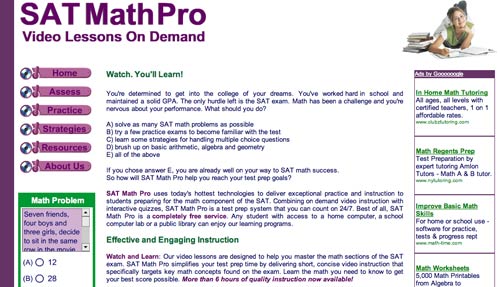« The Beethoven's Ninth Symphony CD Companion | Main | Soliloquy Reading Assistant: Turning the Computer into A Personalized Tutor »
October 24, 2005
Leveling the Playing Field: SAT Math Pro

The SAT test was designed to level the playing field and provide talented students, who have not had the advantage of prep school training, entrée into elite colleges and universities. This crucial test has spawned an entire industry of preparation books, online practice tests, study centers, and private tutors. Access to these tools can help test-takers improve their scores dramatically. But, ironically, most of these products and services are priced out of reach for the very students the SAT is supposed to help.
Enter SAT MathPro, a free online resource that helps students prepare for the math module of the new SAT test. Launched in September 2005, the site grew out of Colleen King's experience as co-director of Math Advantage: a test prep and math tutoring center located in Wellesley, Massachusetts. Ms. King is also the creator two other award-winning math sites: MathPlayground.com for elementary age students and MathTV.org for middle schoolers. She uses a software tool called Camtasia Studio which allows her to record, edit and publish the interactive videos that bring her websites to life. She began these projects when a student, who had been coming to Math Advantage for years, was no longer able to attend classes and the math packets she was sending home to the student seemed inadequate.
"The static explanations could not capture the magic that had taken place in class," she said. "I searched the Web for answers and found Camtasia Studio.I set up my notebook computer, graphics tablet and microphone in the classroom. Each student had a chance to record his or her own unique way of solving the problems. After class, I would record an introduction for the student, and then use MenuMaker to organize the videos on a CD. The final product accomplished two important things: the student was able to learn the new math concepts we were studying and was included, to a large extent, in the classroom dynamic."
Digital tools allowed Ms. King to "create the illusion of an instructor solving a math problem in real time." She was also able to "record virtual manipulatives such as geoboards, number lines, graphs, protractors and rulers, which make the problem solving videos even more instructive." SAT MathPro incorporates techniques Ms. King learned while creating MathPlayground and MathTV. It uses multimedia video and audio to lead students through the test-taking process and to simulate the experience of a teacher "explaining" problem-solving methods and test-taking strategies. The site offers a three-step study process: assessment, practice and strategy.
Students begin by taking an assessment quiz to determine which topic areas require further study. A calculator, geometry reference sheet and timer are provided. Each of the three assessment quizzes consists of 12 questions "covering a broad range of math topics." When the student completes the quiz he/she receives a tally of correct and incorrect answers, an assessment of speed and accuracy, and a checklist of topics that need particular attention.
Clicking on the TV icon next to each question lets the student view a video explanation of the problem and the strategy for finding an answer. Students can control the pace of these mini-lectures, pausing and repeating the lessons as many times as needed. After watching the video tutorial, the student can click "zap it" to receive a follow-up question.
According to the assessment, I needed work on circles, so I proceeded to the "Practice" section and took the "Circles" lesson. The image on the left is a screen grab of the video lesson. A very charming animated chalk writes out the problem on a virtual chalkboard while Colleen King explains the problem-solving strategy.
After the "Practice" session, I studied the all-important "Strategies" section. This resource helps students develop skills to solve problems rapidly. The SAT is a timed test. According to the site, a test-taker has "approximately 75 seconds to read and understand the question, determine a problem solving strategy, work out the solution and mark your selection on the answer sheet." Under those circumstances, time-saving skills are crucial to success. Two of the strategies described on the site are "backsolving" and "picking numbers" both exploit the multiple choice aspect of the test. Readers can also download a useful strategy primer called SAT 2005 - Top Ten Traps and How to Ace Them! A guide to the trickiest problems the SAT has to offer.
This project is a good example of how digital media can be used to create and distribute resources that advance the cause of a free and fair educational system. This effort alone doesn't level the playing field, but it's a step in the right direction.Posted by kim white at October 24, 2005 11:39 AM
